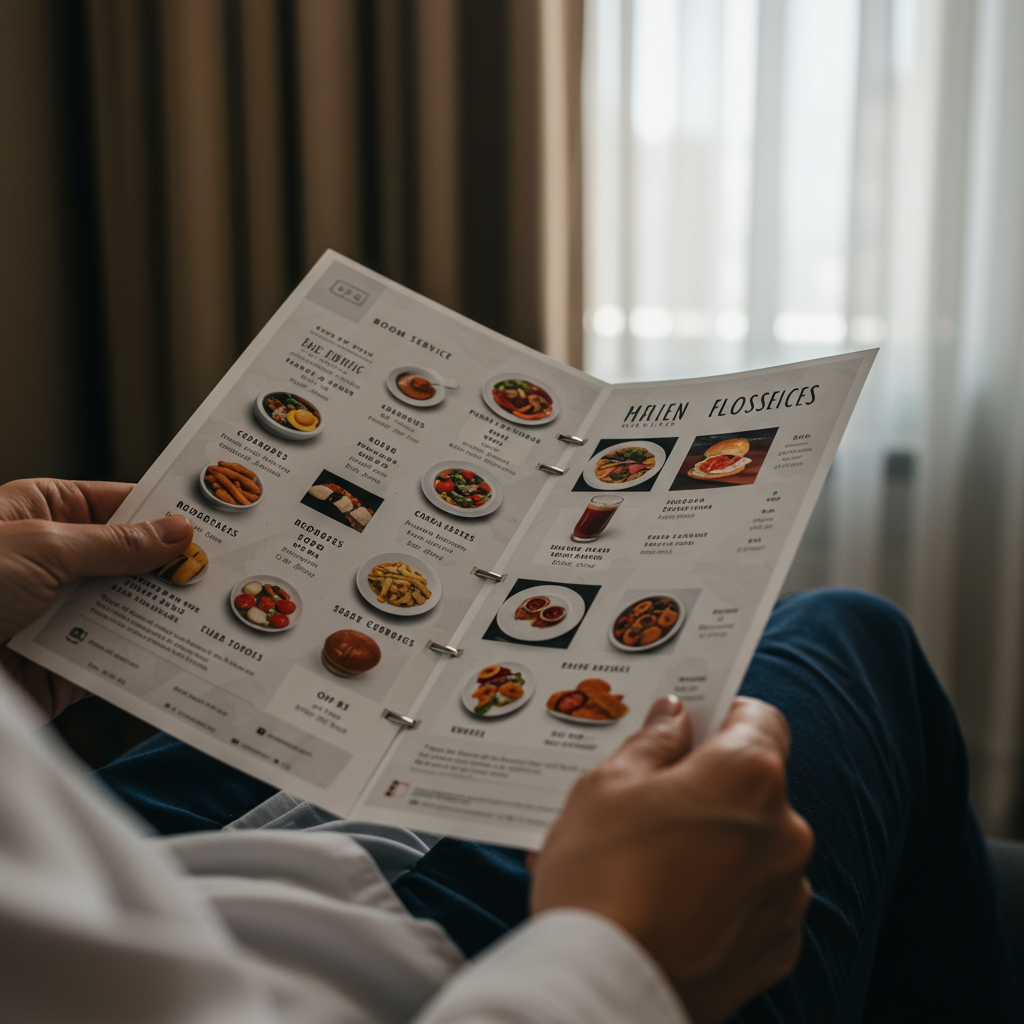
Table of Contents
Introduction
Imagine settling into your hotel room after a long day of travel or business meetings, craving a warm, satisfying meal delivered right to your door without the hassle of venturing out. Hotel room service menus provide exactly this kind of convenience and comfort, transforming your stay into a seamless and indulgent experience. Whether you’re in for a quick snack, a full-course dinner, or a refreshing beverage, knowing how to navigate room service menus can greatly enhance your overall hotel experience.
Hotel room service menus play an essential role in the hospitality industry by bridging the gap between guest convenience and high-quality dining. They are more than just a list of food options; they embody a hotel’s commitment to customer satisfaction, providing a personalized dining experience within the privacy of your own room. As traveler expectations rise, the sophistication and variety of room service menus continue to evolve, catering to diverse tastes, dietary requirements, and time preferences. This evolution reflects larger trends in the hotel industry focused on delivering convenience and luxury simultaneously.
Guests often view room service menus as an important aspect of the hotel stay, offering not only convenience but also a means of comfort and security. Particularly after a tiring day, the ability to order meals or drinks without leaving your room is invaluable. At the same time, today’s travelers frequently seek healthier choices and special dietary accommodations, such as vegan, gluten-free, or allergy-sensitive options. Hotels that understand and implement thoughtful menu variety establish deeper connections with their guests, elevating satisfaction and encouraging repeat visits. This intersection of comfort, choice, and personal care is where room service menus truly shine.
From the hotel’s perspective, room service menus serve strategic purposes beyond guest satisfaction. They represent an additional revenue stream, contributing significantly to a hotel’s profitability while also enhancing its brand reputation. Offering a well-curated menu with diverse offerings helps hotels differentiate themselves in a competitive market. By providing high-quality, readily accessible room service, hotels can create memorable experiences that foster guest loyalty and positive reviews. For guests interested in maximizing their stay, understanding these benefits encourages a more appreciative use of room service amenities.
Before diving into the specifics of hotel room service menus, it’s helpful to explore related hotel features that contribute to a guest’s overall comfort and convenience. For instance, many hotels now emphasize sustainability through eco friendly hotels, integrating environmentally responsible practices even in their dining services. Knowing the hotel breakfast hours helps guests plan their morning orders efficiently, while hotels with amenities like gyms and fitness centers underscore the holistic approach to guest well-being. These features complement room service offerings, creating a well-rounded and satisfying stay.
What You’ll Learn in This Guide
In this comprehensive guide, we’ll walk you through everything you need to know about hotel room service menus. Whether you’re a frequent traveler or planning your first hotel stay, understanding the nuances of room service can transform your experience.
- Understanding the Basics of Room Service Menus: Learn about common meal and beverage options typically available, including how menus cater to different times of day and dietary needs. This will help you know what to expect and how to identify the best choices for your preferences.
- Importance and Benefits for Both Guests and Hotels: Discover why room service menus are a critical component of guest convenience and hotel operations. Understand how they enhance comfort, offer nutritional considerations, and contribute to hotel revenue and brand strength.
- Menu Organization and Ordering Process: Get insights into typical menu layouts, major sections such as starters, main courses, and beverages, along with how to place orders efficiently. Learn about delivery timing and any extra fees you might encounter.
- Tips for Making the Most of Room Service: Equip yourself with practical advice on ordering smartly, saving money, and communicating any special requests. Knowing when and how to contact hotel staff for assistance ensures smoother, more enjoyable service.
As we explore these topics, you’ll gain the knowledge to confidently use hotel room service menus, making your stay not just comfortable but genuinely delightful. The convenience of dining in your room, combined with the tailored services offered by hotels, means you can enjoy every moment of your trip to the fullest. Let’s begin with a deeper look at what these menus typically offer and why they matter so much for you as a guest.
Room service menus often include a variety of breakfast, lunch, dinner, dessert, and snack options. Typical breakfast items might range from classic eggs and pastries to fresh fruit plates, designed to suit early risers or leisurely wake-up calls. For lunch and dinner, expect a selection of sandwiches, salads, and main courses crafted to please diverse palates. Don’t overlook the dessert and snack sections, which can add a delightful touch to your stay, whether it’s a late-night sweet or a light daytime bite. Beverage choices encompass everything from coffee and tea to soft drinks and alcoholic cocktails, catering to all guest preferences and occasions.
Understanding the organization of a hotel room service menu helps simplify your decisions. Most menus are thoughtfully segmented into clear categories such as starters and appetizers, main courses sorted by dietary preference including vegetarian, meat, and seafood options, as well as specialty items and chef recommendations that highlight the hotel’s culinary creativity. Allergy and dietary notes are usually marked prominently to guide guests safely through their selections. Familiarity with this layout allows you to quickly find the dishes that suit your mood, dietary restrictions, or craving without confusion.
The ordering process itself has evolved widely, with most hotels offering multiple convenient ways to place your order. Traditional methods include phone calls to room service, while modern hotels incorporate technology via in-room tablets or mobile apps to simplify and speed up the request. Typical delivery times vary but are generally designed to match guest expectations for prompt and fresh service. Additional fees for delivery or service may apply and are usually outlined on the menu, so being informed prevents surprises when settling your bill.
Remember, making the most of hotel room service means more than just selecting items from a menu. Effective strategies include checking item availability, especially in smaller or boutique hotels where options might rotate daily. Considering portion sizes helps manage costs and avoid waste, and asking about customization or ingredient substitutions ensures your meal aligns perfectly with your tastes or dietary needs. Additionally, keeping an eye out for combo meals or specials can save money without sacrificing quality. Being mindful of service charges and taxes helps you budget accurately for your stay.
In some cases, contacting hotel staff directly can resolve questions or special requests that the menu might not fully address. For example, guests with serious allergies or dietary restrictions should clarify details to ensure safety. Similarly, requesting menu updates for late-night service or providing feedback on delivery timing and order accuracy can improve your experience. Hotels value guest input and often accommodate reasonable requests promptly to maintain high standards of service.
By understanding hotel room service menus thoroughly, guests unlock a level of convenience and personalized care that enhances every stay. This guide prepares you to navigate menus with confidence, make smart ordering decisions, and enjoy the myriad benefits that come with excellent room service. Whether you’re unwinding after a long day or seeking a hassle-free dining option, mastering room service will ensure your hotel experience is as comfortable and enjoyable as possible. Now, let’s delve deeper into the specifics of hotel room service menus and their invaluable role in your travel journey.

Hotel room service menus play a crucial role in shaping a guest’s stay experience, offering a blend of comfort and convenience that enhances overall satisfaction. Beyond just a list of food and beverage options, these menus are thoughtfully crafted to cater to diverse tastes, dietary needs, and schedules of travelers. Diving deeper, it is essential to understand the importance of these menus and how they align with both guest expectations and operational goals of hotels. This discussion will explore how hotel room service menus serve as an integral feature, providing not just sustenance but also a personalized hospitality experience tailored to every guest’s unique preferences and needs.
The Importance of Hotel Room Service Menus
Hotel room service menus are a vital amenity that reflects a hotel’s commitment to guest comfort and convenience. They enable guests to enjoy meals without the need to leave their rooms, particularly beneficial for those with busy schedules, mobility issues, or who simply desire privacy. These menus are designed to accommodate a wide array of dietary requirements, ensuring inclusivity and satisfaction. From the hotel’s perspective, offering a well-curated room service menu enhances guest loyalty by elevating the overall guest experience. It also presents an additional avenue for revenue generation while distinguishing the hotel brand through unique culinary offerings and responsive service.
Having an extensive and well-organized room service menu can set a hotel apart in a competitive market. Hotels often tailor their menus to reflect the local cuisine or to incorporate popular international dishes, thus appealing to a global clientele. Furthermore, menus that accommodate special dietary needs such as gluten-free, vegan, or allergen-friendly options contribute to guest safety and inclusivity. Ultimately, a thoughtfully designed room service menu supports the hotel’s brand promise of comfort, convenience, and exceptional service, making it a strategic asset beyond culinary satisfaction.
Benefits for Guests
Guests reap several key benefits from comprehensive room service menus, enhancing their overall hotel experience. These menus provide 24/7 access to dining, accommodating varied schedules such as early flights or late arrivals. The convenience of in-room dining allows guests to relax fully without needing to explore dining venues. Moreover, the availability of tailored dietary accommodations meets health, ethical, and personal preferences, improving guest satisfaction and comfort.
- Convenient dining without leaving the room: Especially after long travel or during business trips, guests appreciate seamless access to meals without the hassle of changing attire or traveling within the hotel.
- Availability of meals at various times: Room service menus often operate beyond standard restaurant hours, enabling guests to eat on their own timetable which is essential for jet lagged or busy travelers.
- Special dietary accommodations: Modern menus carefully highlight options that cater to allergies, vegetarian, vegan, or gluten-free diets, enhancing safety and choice diversity.
Advantages for Hotels
From an operational standpoint, hotel room service menus contribute significantly to guest satisfaction scores and repeat business. They create a channel for upselling exclusive or premium dishes, increasing food and beverage revenue. A distinctive, well-curated menu also differentiates the hotel in a crowded marketplace, fostering a reputation for quality and attentive service. This can be particularly impactful in luxury or boutique hotels, where personalized services are a competitive advantage.
- Enhances guest satisfaction and loyalty: High-quality room service menus signal that the hotel values guest comfort, encouraging positive reviews and return visits.
- Additional revenue stream: Offering in-room dining options extends the hotel’s food and beverage sales opportunities beyond the restaurant space.
- Brand differentiation: Customized and innovative menus help hotels stand out by aligning with their brand identity and guest expectations, especially in upscale markets.
Common Items Found on Hotel Room Service Menus
The typical hotel room service menu offers a range of items designed to satisfy guests at any time of day. Generally, the menu is segmented into meals and beverages to aid in easy selection. These categories often mirror what would be expected in the hotel’s restaurant but are adapted for the convenience and delivery logistics of room service. Understanding these categories helps guests anticipate the variety and quality they can expect and plan their meals accordingly during their stay.
Menus strive to offer varied options that respect cultural preferences and dietary needs while maintaining a balance between indulgent and healthy choices. Hotels may also rotate menu items seasonally or add chef’s specials to keep the offerings fresh and exciting. The beverage selection likewise caters to all types of preferences, ranging from stimulating coffees to relaxing cocktails, enhancing the in-room dining experience comprehensively.
Meal Categories
Hotel room service meal selections usually cover all three main meals of the day, each with popularly demanded items featuring wide appeal. Breakfast often includes lighter, fresh options, while lunch and dinner menus provide more substantial entrees. Desserts and snacks further complement the offerings, catering to cravings or lighter appetites.
- Breakfast selections (e.g., eggs, pastries, fruit): These options are designed to offer a sustaining start to the day, frequently including customizable eggs, baked goods, and fresh fruits for a balanced morning meal.
- Lunch and dinner entrees (e.g., sandwiches, salads, main courses): These menus often feature diverse proteins, including vegetarian and meat options, alongside sides and soups to create a satisfying meal.
- Desserts and snacks: To round out the culinary experience, sweet treats or light snacks are available, perfect for indulgence or a casual bite between meals.
Beverage Options
Beverage offerings help complete the guest’s dining experience, catering to tastes ranging from refreshing non-alcoholic drinks to sophisticated alcoholic beverages. The menu often highlights popular drink choices to accompany meals or serve as standalone refreshments.
- Alcoholic beverages like wine, beer, and cocktails: Many hotel menus include curated selections of wines and beers, plus classic and signature cocktails that align with the hotel’s style and guest preferences.
- Non-alcoholic drinks including coffee, tea, and soft drinks: A broad variety of caffeine options and soft drinks ensure guests have familiar comforts and energizing choices readily available round the clock.

Conclusion
Hotel room service menus are a key feature that significantly enhances the guest experience by providing unparalleled convenience, comfort, and choice throughout a stay. As we’ve explored, these menus transform dining into a seamless in-room affair, allowing guests to enjoy a diverse range of meals and beverages tailored to various tastes and dietary preferences without ever needing to leave their rooms. This convenience not only caters to busy travelers and those seeking privacy but also offers flexible options that accommodate different schedules, whether it’s an early breakfast, a late-night snack, or a special dietary accommodation. Beyond guest satisfaction, room service menus also serve strategic purposes for hotels, helping to differentiate their brand, increase guest loyalty, and generate important additional revenue streams that contribute to overall hotel profitability.
Typical hotel room service menus are thoughtfully organized into clear categories such as starters, main courses—segmented by vegetarian, meat, and seafood options—and specialty dishes accompanied by chef recommendations. Beverage selections range from refreshing non-alcoholic drinks to carefully curated alcoholic beverages, ensuring that guests can find suitable options for any occasion. Understanding the menu layout and the ordering process, whether by phone or through modern in-room technology like apps and tablets, empowers guests to make swift, informed choices. Being aware of typical delivery times and any associated fees helps prevent surprises and enhances satisfaction with the service.
To make the most out of your hotel room service experience, there are practical steps you can take to ensure convenience and value. Always check menu item availability beforehand, especially in boutique or smaller hotels where selections may vary daily. Consider portion sizes carefully—sharing meals or ordering smaller portions can help manage costs and reduce food waste. Don’t hesitate to ask hotel staff about possible ingredient substitutions or customizations to accommodate your dietary needs safely and deliciously. Keep an eye out for combo meals or specials, which can offer excellent value for money. Lastly, be mindful of any extra service charges or taxes outlined on the menu to budget accurately and avoid unexpected expenses.
Remember, effective communication with hotel staff can further enhance your room service experience. If you have specific dietary restrictions, allergies, or if the menu does not fully cover your needs, contacting the staff directly can help ensure your requests are met precisely. Similarly, if delivery timing or order accuracy needs attention, prompt communication will usually lead to swift resolutions. Hotels appreciate guest feedback and are often eager to accommodate reasonable requests to maintain high service standards, ensuring every stay feels personalized and comfortable.
In summary, understanding and utilizing hotel room service menus unlocks a level of hospitality that significantly boosts comfort and convenience during your travels. These menus symbolize a hotel’s dedication to guest satisfaction and personalized care, making them an invaluable amenity worth exploring thoroughly. For guests looking to elevate their overall hotel experience further, exploring related aspects such as eco friendly hotels, understanding hotel breakfast hours, or enhancing wellbeing by staying at hotels with gyms and fitness centers can provide a holistic approach to a satisfying travel stay. Embrace these services and insights to maximize the pleasure and ease of your accommodations, making every trip more enjoyable and memorable.
